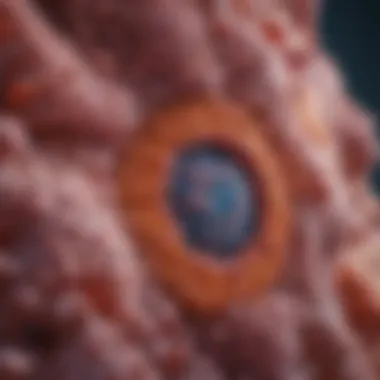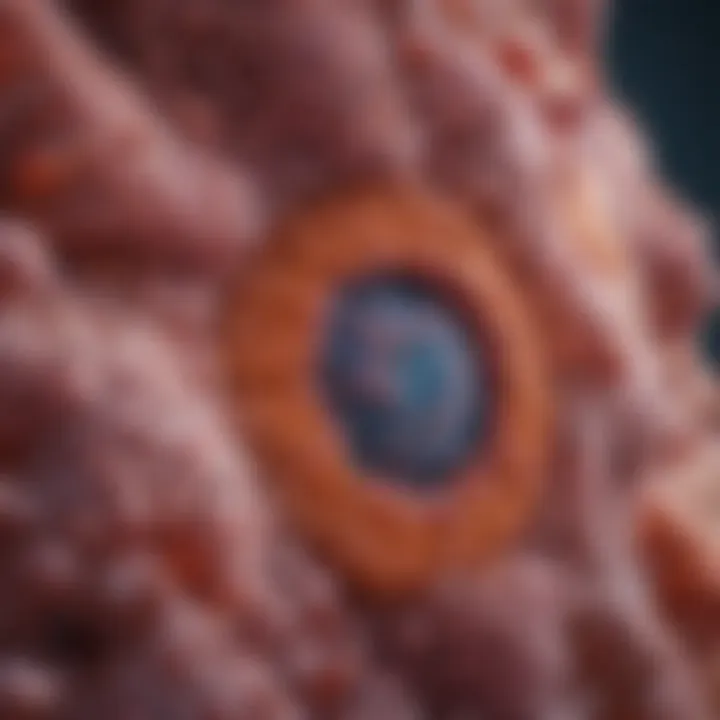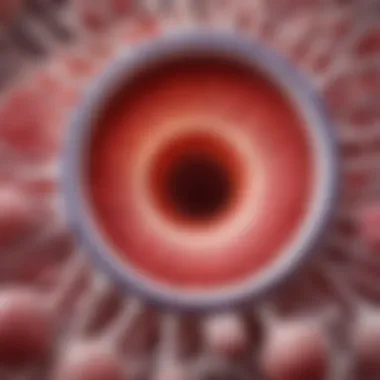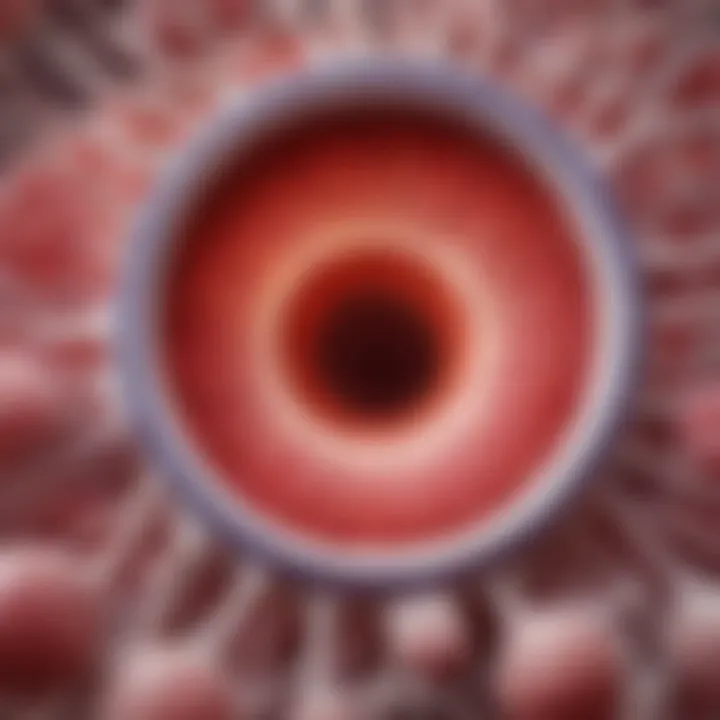Understanding Epithelium: Its Types and Functions


Intro
The study of epithelium plays a crucial role in understanding many biological phenomena. Epithelial tissues line the surfaces and cavities of organs, forming a barrier between different environments. This unique position allows them to perform essential functions such as protection, absorption, and secretion. The complexity of epithelia extends beyond their physical presence; they interact dynamically with both internal and external stimuli, affecting various physiological processes.
This article aims to dissect the epithelium in detail. It will provide insight into the structural varieties, examine their critical functions, and discuss their relevance in health and diseases. From the cellular architecture to the adaptive responses in disease conditions, this exploration will illuminate how epithelial studies influence broader fields like medicine and biotechnology.
Research Overview
Methodological Approaches
Research on epithelium often employs a range of methodologies. Both in vivo and in vitro models are used to study their properties. Recent advancements, such as tissue engineering and 3D cell culture systems, provide invaluable tools to study epithelial tissues in conditions that closely resemble the natural environment. These models enable researchers to evaluate the functional responses of epithelial cells to various stimuli and explore their pathways in disease progression.
Significance and Implications
Understanding epithelium extends its significance into multiple areas. The implications of research findings are notable:
- Medical Advancements: Knowledge of epithelial structures enhances our understanding of diseases such as cancer, particularly in how tumors interact with surrounding tissues.
- Biotechnological Applications: Innovations in drug delivery systems can also be linked to epithelial studies, improving therapeutic efficacy.
- Public Health: Awareness of how epithelial barriers function aids in understanding infection processes and developing preventive measures against diseases.
"The epithelial barrier is not just a physical structure; it is a fundamental element of biological defense mechanisms."
Current Trends in Science
Innovative Techniques and Tools
Recent years have witnessed the emergence of various innovative tools to analyze epithelial tissues more effectively. For instance, CRISPR technology allows for targeted genetic modifications. This can be crucial for studying gene functions in epithelial cells and observing how these changes impact their behavior. Additionally, advancements in imaging technologies, such as live-cell imaging, enable real-time observation of cellular interactions.
Interdisciplinary Connections
The study of epithelium intersects with various scientific fields. For example, the integration of bioinformatics in epithelial research allows for the extensive analysis of gene expression patterns. Furthermore, collaborations between biologists, medical researchers, and bioengineers foster innovative approaches to tackling pressing health issues related to epithelial dysfunction. These interdisciplinary efforts enhance the depth of research and expand the potential applications of findings.
Preface to Epithelium
Epithelium plays a central role within the realm of biological sciences, serving as a foundational element in the organization and functioning of tissues. Understanding epithelium is crucial not just for students and researchers but also for professionals in medicine and biotechnology. This section addresses the importance of epithelial tissues, their variety, and the broader implications of their study.
Epithelial tissues are essentially protective barriers, lining surfaces and cavities throughout the body. They are involved in multiple critical functions including protection, absorption, secretion, and sensation. Their diverse nature reflects adaptability to various bodily requirements. This adaptability results in a dynamic relationship with different systems, making epithelia integral for overall homeostasis.
Key points to consider about epithelial tissue include:
- Location: Epithelial tissues are found almost everywhere in the body, from skin to the lining of internal organs.
- Structure: These tissues are composed of tightly packed cells with minimal extracellular matrix, encouraging efficient barrier function.
- Functionality: They not only protect but also are involved in selective absorption and secretion.
When discussing the introduction of epithelium, one must acknowledge its historical context and the relevant advances in understanding its structure and function. Historical insights provide a background to modern research, illustrating the evolution of epithelium studies. Additionally, various applications of epithelial research span from advancing medical therapies to innovating biotechnological products. Exploring these dimensions can greatly enhance our comprehension of biological systems.
"The essence of epithelial tissue is adaptation and functionality. Understanding its nuances opens new pathways for medical innovation."
In summary, a profound understanding of epithelium establishes a basis for deeper inquiry into both health and disease. As we explore the definition of epithelium next, the historical perspective will further enrich our understanding of this fundamental tissue type.
Classification of Epithelial Tissues
The classification of epithelial tissues is fundamental to understanding their structure and functions in various biological contexts. Epithelial tissues serve critical roles in protecting, absorbing, and secreting substances. By classifying these tissues, we can gain insights into their functions and how they are suited for their specific roles in the body. This classification is based on two primary criteria: the number of cell layers and the shape of the cells.
In this article, we outline the different categories of epithelial tissues with a focus on their unique characteristics and functions. The classifications include simple epithelia, stratified epithelia, pseudostratified epithelium, and transitional epithelium. Each category presents distinct types of epithelial tissues that are instrumental in various physiological processes.
Simple Epithelia
Simple epithelia consist of a single layer of cells. This straightforward structure allows for efficient absorption, secretion, and filtration. Each type of simple epithelium has a specific shape which correlates with its function in the body. The three common forms of simple epithelia are simple squamous, simple cuboidal, and simple columnar epithelium.
Simple Squamous Epithelium
Simple squamous epithelium is comprised of a single layer of flat cells. This type plays a crucial role in facilitating processes such as diffusion and filtration. A key characteristic of simple squamous epithelium is its thinness, which allows substances to pass through easily.
Its unique feature is its presence in areas like the alveoli of the lungs and the lining of blood vessels. The advantages of simple squamous epithelium include its efficient gas exchange in lungs and nutrient exchange in capillaries. However, its thinness also makes it susceptible to damage.
Simple Cuboidal Epithelium
Simple cuboidal epithelium consists of cube-shaped cells and is primarily involved in secretion and absorption. This tissue type is prevalent in glands and the kidney tubules. A key characteristic is its central nucleus, which gives a uniform appearance to the cell shape.
The unique feature of simple cuboidal epithelium is its ability to form glands that produce hormones or enzymes. The advantage of this type is its efficiency in secretion. However, it is less suited for protective roles compared to stratified epithelium.
Simple Columnar Epithelium
Simple columnar epithelium is made up of taller cells that are designed for absorption and secretion, particularly in the digestive tract. A key characteristic is the presence of microvilli, which increase the surface area for absorption.


This tissue's unique feature is the ability to produce mucus through goblet cells, which aids in lubrication. The advantages include effective nutrient absorption and the protective function in the gastrointestinal tract. However, its susceptibility to damage from harsh substances in the digestive system remains a concern.
Stratified Epithelia
Stratified epithelia consist of multiple layers of cells, enhancing their protective functions. This classification is essential for tissues subject to abrasion and chemical exposure. The common types of stratified epithelia include stratified squamous, stratified cuboidal, and stratified columnar epithelium.
Stratified Squamous Epithelium
Stratified squamous epithelium comprises several layers of flat cells. It is crucial for protection against mechanical stress and pathogens. The key characteristic is its ability to regenerate quickly from the base layer.
One unique feature is its keratinized form found in the skin, providing a barrier against environmental damage. Benefits of this epithelium include its robustness and protection, although it may hinder absorption and secretion capabilities.
Stratified Cuboidal Epithelium
Stratified cuboidal epithelium consists of two or more layers of cuboidal cells. This type is less common and typically found in glandular tissue. Its key characteristic is its protective role in glands such as sweat and salivary glands.
The unique feature is its involvement in both secretion and protection. Benefits include versatile glandular functionality, but its rarity can limit its study in comparison with other epithelia.
Stratified Columnar Epithelium
Stratified columnar epithelium features several layers with column-shaped cells primarily found in male reproductive structures and some glands. Its key characteristic is the presence of different cell shapes in various layers.
The unique feature is its specialized role in protection and secretion, allowing for complex functions. Its advantages lie in its structural integrity and multifunctional capabilities, but it is limited in its locations and prevalence.
Pseudostratified Epithelium
Pseudostratified epithelium appears layered due to varying cell heights but is actually a single layer. It is commonly located in the respiratory tract. A significant aspect is its role in secretion and movement of mucus due to ciliated cells. This epithelial type combines characteristics of both simple and stratified epithelium, offering effective protective and secretory functions.
Transitional Epithelium
Transitional epithelium accommodates stretching as it lines the bladder and other parts of the urinary tract. This epithelium is capable of significant changes in shape, allowing for organ expansion. Its key characteristic is its ability to transition between squamous and cuboidal shapes. The unique feature of transitional epithelium is its elasticity, which benefits organs that undergo significant volume changes. However, its limited distribution may constrain broader applications in epithelial studies.
Functions of Epithelial Tissues
Epithelial tissues are essential components of the body's architecture. They perform numerous vital functions that maintain homeostasis and overall health. Understanding these functions is crucial because they reveal how epithelia contribute to the body's resilience against external threats and internal imbalances. This section will explore the four primary functions of epithelial tissues: protection, absorption, secretion, and sensory reception. Each function underscores the complexity and significance of epithelial cells in biological systems.
Protection
Epithelial tissues act as the first line of defense against physical, chemical, and biological harm. They form a barrier between the internal environment and the external world. The skin, for example, is made up of stratified squamous epithelium, providing protection from pathogens and environmental damage. This protective function is vital in preventing the entry of harmful microorganisms and toxins.
Moreover, epithelial cells endure wear and tear from external forces. For instance, in regions such as the oral cavity and esophagus, the continuous shedding and renewal of surface cells ensure that damaged cells are replaced promptly.
Absorption
Another crucial role of epithelial tissues is absorption, particularly in the digestive system. Simple columnar epithelium, found in the intestines, plays a significant role here. The structure of these cells, with their microvilli, increases the surface area for the absorption of nutrients. This specialized epithelial tissue ensures the effective uptake of essential substances, which are vital for sustaining bodily functions. Nutrients, water, and electrolytes are absorbed efficiently, preventing deficiencies that could arise from malabsorption.
Secretion
Secretion is a fundamental function of epithelial tissues, contributing to various physiological processes. Glandular epithelium is primarily responsible for producing and releasing substances. There are two main types of glands: exocrine and endocrine. Exocrine glands secrete substances like sweat, saliva, and digestive enzymes onto epithelial surfaces or into ducts. Endocrine glands, in contrast, release hormones directly into the bloodstream, influencing metabolic processes and maintaining homeostasis.
For instance, goblet cells, which are specialized epithelial cells, secrete mucus in the respiratory and digestive tracts, providing lubrication and protection against irritants or pathogens.
Sensory Reception
Epithelial tissues also have a role in sensory reception. Specialized epithelial cells can detect changes in the environment and relay information to the nervous system. This function is critical for senses like touch, taste, and smell.
For example, taste buds located on the tongue are structures composed of modified epithelial cells that respond to chemical stimuli. This sensory reception is vital for survival, influencing feeding behaviors and alerting an organism to potential dangers in the environment.
Epithelial Cell Characteristics
The section on epithelial cell characteristics is critical for a proper understanding of this vital tissue type. Characteristics of epithelial cells play a key role in their functions and provide insights into their behavior in different biological contexts. This section focuses on cell polarity, cell junctions, and the ability of epithelial tissues to regenerate and renew themselves.
Cell Polarity
Cell polarity in epithelial tissues refers to the structural and functional differences between the apical and basal surfaces of cells. The apical surface faces the lumen or external environment, while the basal surface anchors to the underlying basement membrane. This distinct orientation is essential for the proper functioning of epithelial cells.
One main benefit of cell polarity is that it allows for the selective transport of molecules across the epithelial layer. For instance, in epithelial tissues involved in absorption, such as the intestinal epithelium, nutrients are absorbed from the apical side and transported to the blood vessels on the basal side.
Additionally, polarity influences the organization of cell junctions and ultimately the integrity of epithelial barriers. A loss of polarity is often linked to diseases such as cancer, emphasizing its importance in maintaining normal tissue function.
Cell Junctions


Cell junctions are critical components in maintaining the structural integrity of epithelial tissues. They connect adjacent epithelial cells and facilitate communication and transport between them. There are several types of junctions present in epithelial cells, each with specific roles.
Tight Junctions
Tight junctions serve as a barrier between epithelial cells, preventing the passage of molecules between them. Their primary function is to maintain the polarization of cells. The key characteristic is the presence of specialized proteins that form a seal between neighboring cells. Tight junctions are significant because they help define the apical and basolateral sides of epithelial cells.
The unique feature of tight junctions is their ability to regulate permeability. This advantage is crucial in tissues such as the blood-brain barrier, where selective permeability is necessary to protect the brain from harmful substances.
Adherens Junctions
Adherens junctions provide mechanical stability to epithelial tissues. They connect the actin cytoskeleton of neighboring cells, enabling coordinated movement. A key feature of adherens junctions is the presence of cadherin proteins, which mediate cell-cell adhesion.
Their importance lies in their ability to reinforce tissue integrity under physical stress. However, pathological conditions that disrupt adherens junctions can lead to a loss of tissue structure, contributing to tumor progression.
Desmosomes
Desmosomes are crucial for maintaining strong adhesion between epithelial cells, particularly in areas subjected to high mechanical stress, like the skin. The key characteristic of desmosomes is their dense protein plaques that anchor intermediate filaments. This structure provides resilience to tensile forces.
One significant advantage of desmosomes is their ability to withstand stretching and twisting, making them ideal for tissues needing high durability. However, their disruption can lead to skin blistering disorders, highlighting their essential role in cellular cohesion.
Regeneration and Renewal
Epithelial tissues are known for their remarkable ability to regenerate and renew. This characteristic is fundamental to their roles in protection, absorption, and secretion. Epithelial cells undergo continuous cycles of turnover, where old or damaged cells are replaced by new ones.
The regeneration process is driven by stem cells located in the basal layer of epithelial tissues. These stem cells can divide and produce differentiated cells that migrate upwards to replace those that are lost. The ability to regenerate quickly is particularly important in tissues that are frequently subjected to wear and tear, such as the intestinal lining and skin.
In summary, the characteristics of epithelial cells—cell polarity, the presence of junctions, and their regenerative capabilities—are essential for their diverse functions and contributions to overall health. This understanding of epithelial cell characteristics will guide further discussions on their roles in various physiological and pathological conditions.
Epithelial Development and Differentiation
Epithelial development and differentiation play a critical role in understanding how epithelial tissues form and function throughout the life cycle of an organism. This section focuses on two key aspects: embryonic origin and differentiation pathways. Grasping these concepts not only provides insights into normal biological processes but also sheds light on various abnormalities associated with diseases involving epithelial tissues.
Embryonic Origin
The development of epithelial cells begins early in embryogenesis. Epithelial tissues arise from three primary germ layers: ectoderm, mesoderm, and endoderm. Each layer contributes uniquely to the formation of distinct epithelial types. For example, ectoderm gives rise to the epidermis, lining of the mouth, and nervous system, while mesoderm contributes to structures such as the kidneys and reproductive systems. Furthermore, the endoderm forms the lining of the digestive tract and respiratory system.
Understanding the embryonic origins helps researchers identify how certain epithelial functions are integrated into organogenesis.
The study of embryonic origins can unearth the pathological mechanisms underlying congenital disorders, enhancing our diagnostic abilities.
Differentiation Pathways
Differentiation pathways refer to the processes that lead stem cells to develop into various specialized epithelial cells. This process is governed by a multitude of factors, including genetic regulation, signaling pathways, and microenvironment.
Some key pathways include:
- Notch signaling: Regulates cell fate decisions and maintains a balance between proliferation and differentiation.
- Wnt signaling: Plays a pivotal role in the development and maintenance of epithelial tissues. It influences cellular communication and migration.
- Fibroblast Growth Factor (FGF): Essential for the proliferation and differentiation of epithelial cells, particularly during early development.
The understanding of these pathways is vital for therapeutic strategies in regenerative medicine. Malfunctions in these signaling mechanisms can lead to various disorders, including cancers and degenerative conditions. By targeting these pathways, researchers strive to develop treatments that can restore normal cell function or promote regeneration of damaged tissues.
In summary, the exploration of epithelial development and differentiation unveils the complex network of processes that govern epithelial health and disease. Recognizing how epithelial tissues arise can inform medical advancements and therapeutic interventions, making this area a key focus in biological and health sciences.
Epithelial Pathophysiology
Epithelial pathophysiology represents a crucial area of study within the broader understanding of epithelium. The epithelial layer serves as a barrier, shielding internal organs from external elements and microorganisms. However, when this layer becomes disrupted, it can lead to a range of disorders that affect overall health. Exploring these disorders provides insight into how epithelial cells react under stress and can help in devising targeted therapies. Notably, the pathophysiological changes reflect both the nature of the epithelium and its functional outcomes in different diseases.
Cancer of Epithelial Origin
Cancer of epithelial origin, commonly referred to as carcinoma, is a significant concern in the field of medical research. Carcinomas arise from epithelial cells, which line various organs and tissues. This type of cancer is classified based on the cell shape and type of epithelial layer it affects. Understanding this term is vital because epithelial cancers are among the most common malignancies and can affect diverse body parts, including the skin, lungs, and gastrointestinal tract.
Key characteristics of cancers of epithelial origin include their ability to invade adjacent tissues and metastasize to distant sites. Studies show that identifying genetic markers in epithelial cells can help predict cancer risk. Moreover, these insights are crucial for developing preventative strategies and therapeutics focused on reducing the burden of carcinoma worldwide.
Inflammatory Conditions
Inflammatory conditions linked to epithelial dysfunction are varied, with psoriasis and atopic dermatitis being prominent examples. Both disorders exemplify how dysregulation in epithelial response can manifest in chronic inflammatory reactions.
Psoriasis
Psoriasis is a chronic skin condition characterized by rapid skin cell proliferation. This condition results in thick, red, scaly patches that can cover large areas of the skin. The key characteristic of psoriasis is its chronic nature, often leading to cycles of flare-ups and remission. It is a beneficial topic in this exploration as it reveals insights into autoimmune responses where the immune system mistakenly attacks healthy epithelial cells.
A unique feature of psoriasis is the role of T-cells, which are crucial to the development of plaques. Understanding this mechanism can lead to targeted therapies that specifically suppress T-cell activity, providing relief to patients. The complexity of psoriasis also serves as a case study for understanding the interplay between epithelial cells and immune responses, making it a valuable addition to the discourse.


Atopic Dermatitis
Atopic dermatitis, commonly known as eczema, is another inflammatory condition affecting epithelial tissues. This chronic skin disease leads to dry, itchy skin and is often associated with other atopic disorders like asthma and allergic rhinitis. The key characteristic of atopic dermatitis is its flare-up pattern, often triggered by environmental factors.
A unique feature of atopic dermatitis is the impaired skin barrier function, which allows irritants and allergens to penetrate the skin easily. This malfunction emphasizes the importance of the epithelial barrier in maintaining health. Recognizing the role of the epithelium in atopic dermatitis provides valuable insights for developing therapeutic strategies aimed at restoring barrier function and alleviating symptoms.
Understanding epithelial pathophysiology is fundamental in addressing various health concerns affected by epithelial dysfunction. The insights gained can lead to substantial advances in treatment methodologies for related conditions.
Thus, studying epithelial pathophysiology not only sheds light on specific diseases but also emphasizes the significance of epithelial cells in broader biological contexts.
Techniques in Epithelial Research
Researching epithelial tissues involves a variety of distinct methods. These methods help in understanding the intricate cellular architecture, functions, and pathologies related to epithelial tissues. Techniques in this field not only aid in emerging scientific discoveries but also support the development of medical treatments and biotechnological innovations. By utilizing precise and effective methodologies, researchers can gain deeper insights into the structure-function relationships of epithelia, and assess their response to various stimuli.
Histological Techniques
Histological techniques play a critical role in the visualization and analysis of epithelial tissues. These methods rely on the preparation of thin tissue sections that are stained to enhance contrast under a microscope. Common staining methods include Hematoxylin and Eosin (H&E) staining, which helps differentiate cellular structures, and immunohistochemistry that uses antibodies for detecting specific proteins within the tissues.
Benefits of histological techniques include:
- Detailed Visualization: Histological staining provides a clear view of tissue architecture, cellular arrangement, and boundaries.
- Pathological Assessment: Pathologists can identify abnormalities, such as tumors or inflammatory conditions, by examining stained slides.
- Comparative Studies: These techniques facilitate comparisons between healthy and diseased tissues, supporting the understanding of various diseases.
However, histological techniques are not without their limitations. They often require specialized skills for proper interpretation and may not reveal functional information at the molecular level. Despite this, histology remains indispensable in epithelial research, especially within clinical settings.
Molecular Techniques
Molecular techniques have become increasingly vital in understanding the biochemical and genetic aspects of epithelial cells. These approaches allow researchers to explore the molecular underpinnings of epithelial differentiation, function, and pathology. Techniques such as PCR (Polymerase Chain Reaction), Western blotting, and RNA sequencing enable scientists to assess gene expression profiles and protein interactions.
Key characteristics of molecular techniques include:
- Specificity: Molecular methods can detect specific nucleic acids or proteins, allowing for targeted studies on particular functions or diseases.
- Quantitative Analysis: Techniques like quantitative PCR enable precise measurements of gene expression levels, providing insights into tissue responses under different conditions.
- Functional Insights: Molecular analyses can uncover mechanisms behind diseases, such as how cancerous transformations occur in epithelial cells.
Nevertheless, the interpretation of results from molecular techniques can sometimes be complex and require significant expertise. Furthermore, these methodologies can be time-consuming and necessitate sophisticated equipment.
Overall, both histological and molecular techniques are essential tools in epithelial research. They complement each other and help provide a comprehensive understanding of epithelial tissues in various biological contexts.
The ongoing developments in both methodologies are central to advancing research in epithelial biology and its implications for health and disease.
Applications of Epithelial Studies
The study of epithelial tissues has broad implications across various fields. Understanding how these tissues function and how they can be manipulated is essential for significant advancements in healthcare and biotechnology. This section focuses on the applications of epithelial studies, which reveal their potential impact and benefits.
Epithelial cells serve as a barrier and are crucial for maintaining homeostasis in organisms. Their role in protection, absorption, and secretion makes them central to both health and disease processes. For example, knowledge about epithelial tissues has led to improved diagnostic methods and therapeutic strategies. Understanding diseases that affect these tissues, such as cancers, can lead to more effective treatments and patient management.
Specifically, applications in medicine and biotechnology are notable. Medical applications often involve regenerating damaged epithelial tissues or targeting malignancies. In biotechnology, advancements enable the development of artificial tissues and drug delivery systems. Each use case offers unique insights and advantages for researchers and professionals.
Medical Applications
Medical studies of epithelial tissues have unveiled important insights into various health conditions. One major area is cancer, as many tumors originate from epithelial cells. Detailed understanding of tumor behavior can enhance treatment strategies.
Key benefits include:
- Early Detection: Techniques such as biopsy allow for the examination of epithelial cells to detect cancer at an earlier stage.
- Targeted Therapies: Knowledge of specific molecular pathways can lead to targeted treatments that are more effective and less toxic than traditional chemotherapy.
- Regenerative Medicine: Developing methods to replace or repair damaged epithelial tissues is a growing field. Stem cell therapy is one example where epithelial cells can be regenerated for reconstruction.
These medical applications illustrate how foundational epithelium research can directly influence patient outcomes and advance clinical practices.
Biotechnological Innovations
Epithelial studies also pave the way for innovations in biotechnology. These innovations often translate into real-world applications in healthcare, pharmaceuticals, and material science.
Several areas where epithelial research contributes include:
- Tissue Engineering: Creating artificial skin or organoids from epithelial cells holds promise for transplantation and disease modeling.
- Drug Delivery Systems: Utilizing epithelial cells to enhance the absorption and delivery of therapeutic agents provides better patient care. Epithelial barriers can be engineered to improve drug bioavailability.
- Diagnostic Tools: Epithelial cells can be utilized to develop biosensors for detecting pathogens or other biomolecules, leading to rapid diagnostics.
The integration of epithelial studies in biotechnological fields highlights the interplay between fundamental research and practical applications, enhancing the understanding of biological systems and contributing to innovative solutions.
In summary, applications of epithelial studies have a far-reaching impact on medicine and biotechnology. This ongoing research is essential for the future of health sciences and the development of new technologies. Through achieving a deeper comprehension of epithelium, we can expect continued progress in addressing complex health challenges.
Future Directions in Epithelial Research
Research on epithelium continues to evolve, revealing deeper insights into its structure, functions, and roles in various diseases. Understanding future directions in epithelial research holds significant importance as it sets the stage for innovations that can enhance our knowledge and treatment of epithelial-related conditions. The investigation into epithelia has implications for developing new therapeutics, improving diagnostic techniques, and understanding complex pathologies.
Emerging technologies are applying advanced methodologies, such as 3D cell culture systems and organ-on-chip models. These technologies mimic the native environment of epithelial tissues more accurately than traditional methods. They allow researchers to obtain data that is closer to actual biological processes. This results in improved understanding of drug responses and disease mechanisms. Researchers are also utilizing CRISPR technology for gene editing to study epithelial cell functions more precisely. These advancements provide avenues for targeted treatments and personalized medicine, which can significantly enhance patient outcomes.
Interdisciplinary approaches are essential in pushing the boundaries of epithelial research. Collaboration among biologists, bioengineers, and data scientists fosters comprehensive investigations. For instance, integrating computational modeling with biological experimentation enhances the understanding of epithelial responses to environmental stressors. Such collaborations enable the development of sophisticated models that can predict how epithelial tissues react in various conditions. Moreover, interdisciplinary research promotes innovation, driving breakthroughs in disease prevention and treatment strategies.
Innovation in research is critical for advancing epithelial studies and improving clinical applications.



